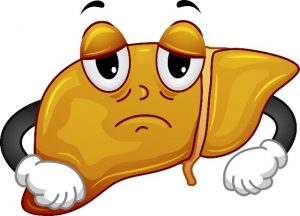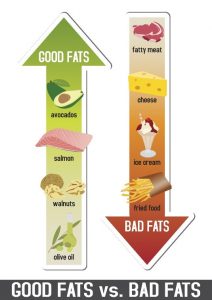What Causes Fatty Liver Disease?
Author: Dr. Stephen Chaney
 The great American food fight continues. The low fat enthusiasts tell you saturated fat is going to kill you. The low carb enthusiasts tell you saturated fat is fine. It’s sugar that’s going to kill you.
The great American food fight continues. The low fat enthusiasts tell you saturated fat is going to kill you. The low carb enthusiasts tell you saturated fat is fine. It’s sugar that’s going to kill you.
You can find studies that support either viewpoint. And the story keeps changing. One day the headlines proclaim: “The latest study shows…” A few weeks later you see a headline saying: “Wait. That’s wrong. Science now shows…” It’s no wonder you are confused and perhaps a bit cynical.
So, what’s worse saturated fat or sugar?
Perhaps we should step back and ask how we got to this point.
Why Is the Saturated Fats and Sugar Dilemma So Confusing?
 To understand why the literature around saturated fats and sugar is so confusing, we need to go back to the 1950s. The first studies implicating saturated fats as a risk factor for heart disease replaced saturated fats with unsaturated fats. Everything else in the diet was kept the same. When you do that, the answer is clear-cut. Saturated fats increase heart disease risk and unsaturated fats decrease heart disease risk.
To understand why the literature around saturated fats and sugar is so confusing, we need to go back to the 1950s. The first studies implicating saturated fats as a risk factor for heart disease replaced saturated fats with unsaturated fats. Everything else in the diet was kept the same. When you do that, the answer is clear-cut. Saturated fats increase heart disease risk and unsaturated fats decrease heart disease risk.
When the American Heart Association first recommended a low-fat diet, they had in mind replacing saturated fats with fresh fruits, vegetables, whole grains, and beans. The remaining fat would be mostly unsaturated. Today, we would call that a Mediterranean diet, which, by the way, has been shown to reduce both diabetes and heart disease risk.
Big Food Inc. took one look at that and panicked. They make their money from processed foods, not from fresh fruits and vegetables. If the American people made the changes the American Heart Association recommended, Big Food Inc. would go bankrupt.
They sprang into action. They had their laboratories whip up processed foods that replaced fat with sugar, white flour, and a witch’s brew of chemicals. Then they told the American people: “Never fear. You don’t have to give up your favorite foods. We have created low fat versions of the foods you love.”
That became the diet that most Americans adopted. Even worse, most Americans continued eating foods high in saturated fats. We ended up with the worst of all possible worlds – a diet high in saturated fat and high in sugar. This became the Standard American Diet (SAD).
This shift has corrupted most of the recent research studies on saturated fat and sugar. Most of the studies on saturated fat or sugar have compared them with the Standard American Diet, not with a healthy diet. When you do that, your results are going to be skewed. Almost anything is better that the Standard American Diet.
Why Was This Study Done?
 When we think of obesity, we think of the excess fat we can see. But what we have learned in recent years is that the fat you can’t see is far more damaging to our health. I am talking about fat stores in the liver, something called fatty liver disease.
When we think of obesity, we think of the excess fat we can see. But what we have learned in recent years is that the fat you can’t see is far more damaging to our health. I am talking about fat stores in the liver, something called fatty liver disease.
Fatty liver disease has serious consequences. It causes insulin resistance and inflammation, and that increases the risk of diabetes and heart disease. Even worse, it can lead to cirrhosis and liver failure.
Excess sugar is converted to saturated fat in the liver. Therefore, the popular literature attributes the epidemic of fatty liver disease to increased intake of simple sugars. But is it true? Saturated fats require no conversion. They can simply be deposited in the liver as is. Shouldn’t they be at least as damaging to the liver as sugar?
It turns out that no studies have actually compared the effect of excess calories in the form of saturated fat, unsaturated fat, and simple sugars on fat accumulation in the liver. This study (PK Luukkonen et al, Diabetes Care, 41: 1732-1739, 2018) was designed to fill that gap.
How Was The Study Done?
 The authors enrolled 38 middle aged (average age = 48), overweight (average BMI = 31) adults for the study. The participants were divided into three groups and were fed an extra 1,000 calories per day of saturated fat (SAT group), unsaturated fat (UNSAT group), or sugar (SUGAR group) for 3 weeks. The composition of those extra 1,000 calories was as follows:
The authors enrolled 38 middle aged (average age = 48), overweight (average BMI = 31) adults for the study. The participants were divided into three groups and were fed an extra 1,000 calories per day of saturated fat (SAT group), unsaturated fat (UNSAT group), or sugar (SUGAR group) for 3 weeks. The composition of those extra 1,000 calories was as follows:
- The SAT group ate an extra 30 g coconut oil, 40 g butter, and 100 g blue cheese
- Macronutrient composition = 1% carbohydrate, 86% fat, 13% protein, 0% simple sugars.
- Fat composition = 76% saturated fats, 21% monounsaturated fats, 3% polyunsaturated fats
- The UNSAT group ate an extra 36 g olive oil, 26 g pesto, 54 g pecans, and 20 g butter
- Macronutrient composition = 2% carbohydrate, 91% fat, 7% protein, 0% simple sugars.
- Fat composition = 21% saturated fats, 57% monounsaturated fats, 22% polyunsaturated fats
- The SUGAR group ate an extra 9.5 ounces of orange juice, 16 ounces of sugar-sweetened beverages, and 200 g of candy.
- Macronutrient composition = 100% simple sugars.
Compliance to these dietary additions was confirmed by measuring the fat composition of serum triglycerides. As expected, the triglycerides were primarily composed of saturated fat in the SAT and SUGAR groups and unsaturated fats in the UNSAT group.
None of the participants had diabetes or other diseases, pre-existing liver disease, excessive consumption of alcohol (which can also lead to fatty liver disease). They were also not taking any drugs that could influence glucose or lipid metabolism.
Upon entry into the study, the three groups were comparable with respect to age, sex, BMI (a measure of obesity), amount and type of fat stores in the liver, and insulin sensitivity.
The baseline diet to which the extra calories were added was also comparable between the three groups and did not change during the study. That meant that the only difference between groups was the composition of the extra calories they consumed.
What Causes Fatty Liver Disease?
- All 3 groups gained weight, but the weight gain was slightly larger (0.6 pounds) for the SAT and SUGAR groups than for the UNSAT group (0.4 pounds).
- Fat stores in the liver increased by 55% in the SAT group, 33% in the SUGAR group, and 15% in the UNSAT group.
- The fat stores were primarily saturated fat in the SAT and SUGAR groups and primarily unsaturated fat in the UNSAT group.
- Insulin resistance was increased in the SAT group, but not in the SUGAR and UNSAT groups.
Previous studies have suggested that the effect of liver fat stores on insulin resistance might be mediated by fat metabolites called ceramides. Therefore, they also measured plasma ceramide levels.
- Plasma ceramides were increased in the SAT group, but not in the SUGAR and UNSAT groups.
Previous studies have also suggested that the effect of saturated fat on insulin resistance might be mediated by a change in gut bacteria that produce endotoxins which end up in the bloodstream.
- A change in gut bacteria and an increase in plasma endotoxins was observed in the SAT group, but not in the SUGAR and UNSAT groups.
What is Worse Saturated Fat Or Sugar?
 The authors of this study concluded: “Saturated fat induced the greatest increase in fat stores in the liver, insulin resistance, and harmful ceramides. Decreased intakes of saturated fat could be beneficial in reducing fat stores in the liver and the associated risk of diabetes.”
The authors of this study concluded: “Saturated fat induced the greatest increase in fat stores in the liver, insulin resistance, and harmful ceramides. Decreased intakes of saturated fat could be beneficial in reducing fat stores in the liver and the associated risk of diabetes.”
Is that statement true? This study was well designed. However, this is a very small study. It needs to be replicated by larger studies. In the meantime, we can ask if the findings are consistent with previous studies.
You may have noticed, the authors included three variables in their study (saturated fats, unsaturated fats, and simple sugars), but I focused only on the comparison between saturated fats and simple sugars in this article. That is because the damage caused by saturated fats versus simple sugars is controversial in the popular literature. In contrast, most (but not all) experts agree that saturated fats are worse for you than unsaturated fats.
Let’s start with the relatively non-controversial comparison (saturated fats versus unsaturated fats) before turning to the comparison between saturated fats and simple sugars. When comparing saturated fats and unsaturated fats, the author’s conclusion that saturated fats are worse for you is probably true.
- In this study saturated fats caused greater fat accumulation in the liver than unsaturated fats, and these differences were statistically significant.
- The fat stores in the liver mirrored the fat composition of the diet. Saturated fat caused saturated fat stores. Unsaturated fat caused unsaturated fat stores.
- Saturated fats increased insulin resistance while unsaturated fats did not.
- This is consistent with several previous studies that have shown:
- Saturated fats cause greater fat accumulation in the liver than polyunsaturated fats in younger, normal weight individuals.
- High saturated fat intake is associated with fatty liver disease and insulin resistance.
- Saturated fat increases heart disease risk, while unsaturated fat decreases heart disease risk.
However, the differences between saturated fats and sugar were less clear.
- In this study saturated fats caused greater fat accumulation in the liver and more insulin resistance than simple sugars.
- The conclusion that saturated fats are worse for you than simple sugars was strengthened by the following:
- Saturated fat caused insulin resistance, while simple sugars did not.
- Saturated fat caused a change to gut bacteria which resulted in increased endotoxin levels in the bloodstream, while simple sugars did not.
- The conclusion that saturated fats are worse for you than simple sugars was weakened by the following:
- The difference in fat accumulation in the liver was not statistically significant. A larger study may have provided a more definitive answer.
- Previous studies have suggested that saturated fats and simple sugars may be equally bad for you. They both increase the risk of diabetes and heart disease.
Clearly, this study does not end the debate about whether saturated fats or simple sugars are worse for you. However, it does provide a new perspective.
Previous studies have not compared the effects of saturated fat and sugar on fatty liver disease when all other aspects of the diet were identical. If the observations of this study are confirmed in subsequent studies, it could influence how we evaluate the relative risks of saturated fats and sugars in the future.
What Does This Study Mean For You?
When you strip away all the noise, there are three obvious conclusions from this and most previous studies:
- Excess calories in any form are bad for us. We don’t just store fat in the liver, and fat stores in other parts of our body have bad effects on our health as well.
- Unsaturated fats are better for us than saturated fats. They reduce the risk of heart disease. This study suggests they also reduce the risk of fatty liver disease, insulin resistance, and possibly diabetes.
- The jury is still out on the health consequences of saturated fats versus simple sugars. This study suggests that simple sugars may be less likely to cause fatty liver disease. While fatty liver disease can lead to diabetes and heart disease, so can fat stores anywhere else in the body. Other studies suggest that excess calories as saturated fats and simple sugars are equally likely to lead to obesity, diabetes and heart disease.
My recommendation is to avoid both saturated fats and simple sugars. Don’t focus on low fat diets or low carb diets. Instead focus on whole food diets with healthy fats and healthy carbs.
The Bottom Line
Fatty liver disease has serious consequences. It causes insulin resistance and inflammation, and that increases the risk of diabetes and heart disease. Even worse, it can lead to cirrhosis and liver failure.
Excess sugar is converted to saturated fat in the liver. Therefore, the popular literature attributes the epidemic of fatty liver disease to increased intake of simple sugars. But is it true? Saturated fats require no conversion. They can simply be deposited in the liver as is. Shouldn’t they be at least as damaging to the liver as sugar?
A recent study compared the effect of diets high in saturated fats (SAT group), unsaturated fats (UNSAT group), or simple sugars (SUGAR group) on fat accumulation in the liver. The results were:
- Fat stores in the liver increased by 55% in the SAT group, 33% in the SUGAR group, and 15% in the UNSAT group.
- The fat stores were primarily saturated fat in the SAT and SUGAR groups and primarily unsaturated fat in the UNSAT group.
- Insulin resistance was increased in the SAT group, but not in the SUGAR and UNSAT groups.
The authors of this study concluded: “Saturated fat induced the greatest increase in fat stores in the liver and insulin resistance. Decreased intakes of saturated fat could be beneficial in reducing fat stores in the liver and the associated risk of diabetes.”
My recommendation is to avoid both saturated fats and simple sugars. Don’t focus on low fat diets or low carb diets. Instead focus on whole food diets with healthy fats and healthy carbs.
For more details on the study and what it means for you, read the article above.
These statements have not been evaluated by the Food and Drug Administration. This information is not intended to diagnose, treat, cure or prevent any disease.

